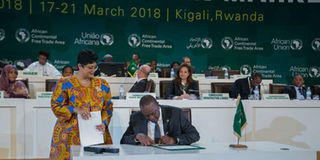Africa trade pact will boost local industry

President Uhuru Kenyatta signs the agreement establishing the African Continental Free Trade Area, on March 21, 2018 in Kigali, Rwanda. PHOTO | NATION MEDIA GROUP
What you need to know:
- If well executed, the AfCFTA could trigger the creation of jobs for the millions of unemployed African youth.
- African countries must collectively adopt a remarkable turnaround on their industrial transformation policies.
At its 2012 summit, the African Union validated a plan to set up an African Continental Free Trade Area by 2017.
Six high-profile deliberations later, Africa is on the cusp of realising the African renaissance dream envisioned by post-Independence Pan-African visionaries.
On Wednesday, the AU chairman, Rwanda’s President Paul Kagame, joined by Kenya’s President Uhuru Kenyatta and other African leaders, signed the continental trade deal and ushered in, perhaps, the biggest bet yet on Africa.
The AfCFTA will single-handedly create a single market for goods and services in Africa, possibly growing intra-Africa trade from 12 per cent to nearly double that by 2022.
This will create demand for manufactured goods and exponentially lead to growth in industrial production.
EMPLOYMENT
Kenya’s manufacturing sector contributes a paltry 10 per cent to gross domestic product (GDP).
A well-executed AfCFTA will increase the manufacturing-to-GDP figure by contributing as much as $3.4 trillion by the year 2050.
Going by the massive billion-strong African population, Kenya stands to gain a lot.
The expected catalytic effect is a long-yearned-for fundamental transformation of African economies, which should positively tilt their growth potential and structurally transform them.
If well executed, the AfCFTA could trigger the creation of jobs for the millions of unemployed African youth.
But that has to be driven by a recalibration of trade between African countries.
PRIVATE SECTOR
To spur the great opportunity heralded by the AfCFTA, African countries must collectively adopt a remarkable turnaround on their industrial transformation policies.
They should focus on building more diversified economies driven by the private sector, a revamped and responsive business environment and low costs of doing business, amongst other critical enablers.
It’s notable that Kenya has already made tangible strides in bolstering those key elements.
Through the ongoing 10-year industrialisation blueprint, a distinguishable cog in the Kenyan government’s second-term 'Big Four' agenda, Kenya has positioned itself for this new renaissance.
INVESTMENT
In fact, much of our economy is driven by the private sector — a result of a mutual public-private cooperation that has worked well to achieve joint development objectives for the country as a whole.
Creating a conducive business environment has seen investment levels in Kenya rise from $390 million in 2013 to nearly $2 billion in 2016.
To be able to create manufacturing opportunities for the future, this momentum must be sustained going forward.
In relation to that, bringing down the cost of doing business through addressing inefficiencies associated with energy, infrastructure, arbitration processes, bureaucracies and corruption must be dealt a fatal blow.
YOUTH LABOUR
Kenya has one of the most reputable labour force in Africa, which gives its youth an opportunity to leverage on not only building our industrialising economy but also play a part in transferring their skills across the continent.
This will leverage existing landmark agreements such as the African Growth and Opportunity Act (Agoa) with the United States and the Economic Partnership Agreement (EPA) with the European Union to boost our growth.
Indeed, this is a new lease of life for Africa and Kenya is excited to be at the heart of it.
Mr Mohamed the Industry, Trade and Cooperatives Cabinet Secretary. Twitter: @AdanMohamedCS





